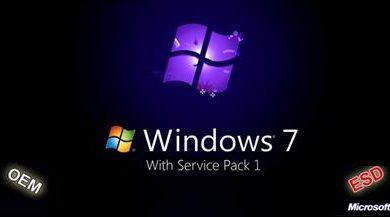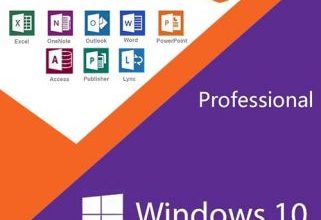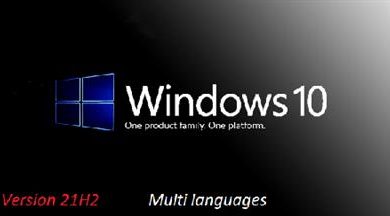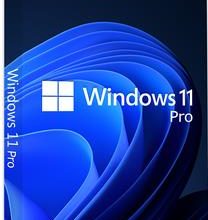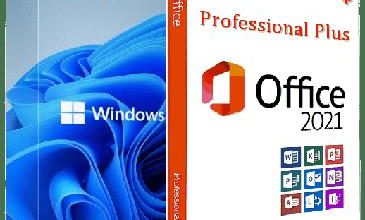Windows 11 Pro 22H2 Build 22621.1702 with Office 2021 x64 by BoJlIIIebnik (RUS/ENG/2023)
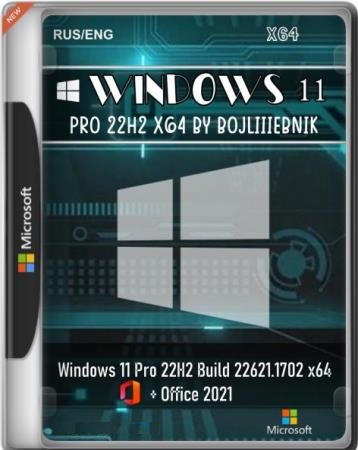

Windows 11 Pro 22H2 Build 22621.1702 with Office 2021 x64 by BoJlIIIebnik (RUS/ENG/2023)
Windows 11 Pro 22H2 by BoJlIIIebnik – the assembly was created based on the original, official images from Microsoft 22H2, the latest updates until May 2023 are integrated. The system has Office 2021 installed. Adware applications that are responsible for installing adware applications and other garbage have been removed from the system, trackers that send anonymous reports to Microsoft, as well as pre-installed unnecessary applications such as Skype, etc. have been removed.
Program information:
Year of issue: 2023/18.05
Platform: (x64)
Interface language: Russian / English
Medicine: not required / cured | pre-activated
File size: 4.32 GB
When creating an assembly, important system components whose operation is undesirable (analyzers of user actions, speech, etc.) were not deleted, but simply disabled. Thus, the system retained its stability in operation, the ability to update, and also passes the integrity test of system files sfc /scannow, but at the same time retained the same level of privacy as in the case of their complete removal (for more details, see “Removed” and “Disabled” ).
The system has the latest updates and a minimum set of applications such as Office 2021, WinRAR and Notepad ++ (read more “Installed”).
Simplicity and ease in installation. During installation, the user must specify the language, the disk on which the system will be installed, the username and password (optional). The system will automatically activate itself. During installation, the system uses Compact OS technology as needed. (See “Installation process” for details).
Installed:
• Latest updates at the time of build creation
• Microsoft Office 2021 LTSC Pro Plus (included: Word, Excel, Access, Outlook, OneNote, PowerPoint, Publisher) (KMS automatic activation)
• WinRARv. 6.21.0 (activated)
• Notepad++v. 8.5.3
Removed:
• Content delivery manager (responsible for the automatic installation of advertising applications)
• Cortana
• Feedback Hub (sending bug reports to Microsoft)
• Get Help
• Microsoft Office Hub (preinstalled)
• Microsoft Sticky Notes
• Clipchamp
• Widgets (can be installed back, see “Frequently Asked Questions FAQ”)
• Windows Mail
• OneDrive (can be installed back, see “Frequently Asked Questions FAQ”)
• Skype (preinstalled)
• Application “Initial Windows prompts”
• Application “Movies and TV”
• Application “People”
• Application “Link to phone”
• Microsoft News app
• Telemetry and other applications responsible for collecting and sending reports to Microsoft
Attention ! The assembly removed the minimum number of applications, without which the system passes the sfc /scannow test, and also retains the ability to update. All other important system components, the operation of which is undesirable and affect the user’s privacy, are completely disabled. The list of disabled applications can be found in the “Disabled” tab.
Disabled:
• SmartScreen (can be turned back on, see “Frequently Asked Questions FAQ”)
• Windows Defender (can be turned back on, see “Frequently Asked Questions FAQ”)
• Automatic download and installation of system updates (now only notifies the user when updates are available)
• Automatic sending of analytical data about the text entered by the user
• Automatic reboot on BSOD
• Automatic system restart to install updates
• Automatic installation of advertising and recommended applications
• Automatic driver updates (now automatically loads the driver only if not installed)
• Automatic update of speech models
• Automatic connection to open access points
• Automatic installation of the application “Teams”
• Analysis of the entered text, analysis of how the user enters text and sending data to Microsoft
• Geolocation (can be turned back on, see “Frequently Asked Questions FAQ”)
• Tracking Windows running applications
• Tracking Windows open documents
• Online speech recognition services
• Display Bing search results in search
• Sending data to Microsoft to personalize speech and text input by the user
• Use of advertising ID by advertising applications
• Allow Microsoft to use the user’s diagnostic data to provide more tailored advertising
• Display of suggested content
• Showing tips, facts and so on. on the lock screen
• Show frequently used folders in “quick access”
• Show frequently used files in “quick access”
• Display “Widgets” on the taskbar
• Show “Chat” on the taskbar
• Display of offers (advertising tiles) in Start
• Search files in “OneDrive” and “SharePoint” from taskbar search
• Collection of data about the user and his actions
• Collection of handwritten text input, text input and contacts
• Telemetry
• Experimentation on the OS by Microsoft (now Microsoft cannot remotely change system settings for testing)
Other settings:
• Show “This PC” on desktop
• Show “Trash” on desktop
• Enabled dark theme for Windows and applications
• Allow local account creation without internet
• Allow installation of the system on devices that do not meet the minimum requirements (successfully pass TPM, SecureBoot, RAM Check during installation)
• Compact OS (read more “Installation process”)
Installation process:
Writing an image to media
The first step is to create a bootable USB flash drive or bootable DVD.
To create a bootable USB flash drive, you need to write the entire contents of the ISO image to it. For convenience, I recommend using the Rufus program.
To create a bootable DVD, burn the entire contents of the ISO image onto it.
Operating system installation
Important! Before installation, it is recommended to turn off the Internet.
To start the installation process, we need to boot from the media to which we have written the installer. To do this, we call the Boot Menu and select our media from the list.
We select the language, the disk on which we will install the system. You need to install the system on a blank formatted disk.
After installation, specify the username and password as desired.
Ready!
If error 0xC0000005 occurs during installation:
1. Try to burn a bootable flash drive with the following parameters:
• Partition scheme – GPT
• File system – NTFS
2. Use another USB port (if there is USB 2.0, use it).
If the problem is not fixed, then :
3. Try the following series of actions:
1) When the installation starts and it is proposed to select a partition – delete all partitions of the disk on which we will install the system, the system will create new system partitions during installation that it needs.
In my case, the disk (Disk 0) on which I am going to install the system is divided into 4 partitions, they all need to be deleted.
After deletion, we get “Unallocated space on disk 0”.
2) Using the command line, we check whether the style of the disk partition table matches the one on the bootable flash drive – GPT or MBR.
2.1) [Shift] + [F10]
2.2) diskpart
2.3 list disk
If there is * in the table in the GPT column, then the disk is GPT.
If MBR, then change to GPT: select disk N (where N is the disk number in the table called by the list disk command) > clean > convert gpt
After the commands, the disk becomes gpt.
Select “Unallocated space on disk 0” (in my case) and click the “Next” button. The system should install normally.
Compact OS technology
Compact OS technology saves 2-3 GB of disk space by compressing system files. During the installation process, the system itself chooses to use this technology in your case or not.
To check the status of Compact OS, enter at the command prompt as an administrator: “compact.exe /CompactOS:query” (without quotes).
If Compact OS technology has not been applied, but you want to apply it, enter “compact.exe /CompactOS: always” (without quotes) in the command line as an administrator.
To cancel compression, type “compact.exe /CompactOS: never” (without quotes) at the command prompt as an administrator.
Treatment procedure:
Activation of the operating system and Office occurs completely automatically without the actions of the KMS user himself by the activator.
If the system did not activate automatically, use the activator on the desktop in the “KMSActivator” folder.
System requirements:
• Processor: 2 (GHz) or more cores on a compatible x64 processor or system on a chip (SoC)
• 4 GB of RAM and above
• Hard disk space: 64 GB
• Trusted Platform Module (TPM) (bypassed)
• Video adapter: DirectX 12 or later with WDDM 2.0 driver.
• Screen: 1280×720 and above
Checksums:
CRC32: 122E373C
MD5: B76D377BF2A979E863950D61B833CEE4
SHA-1: 4191491FD9CE92D2B24A215A94CEE95B0A0482CA
SHA-256: 6A05B2F434150E4C6A5DE81FB34095A90B619EE9AD5BF0F2AD1BB0D3FDC3E117
http://peeplink.in/ab2a50631097
Password PeepLink: 123
Uploadgig
11Pro%2022H2.22621.1702.BoJlIIIebnik.part1.rar
11Pro%2022H2.22621.1702.BoJlIIIebnik.part2.rar
11Pro%2022H2.22621.1702.BoJlIIIebnik.part3.rar
NitroFlare
http://peeplink.in/8b1cc778fb20
